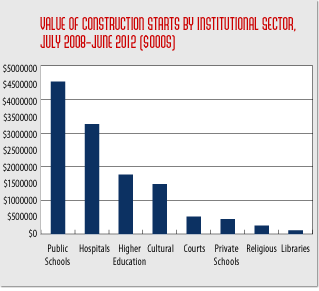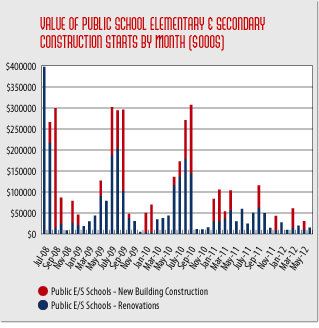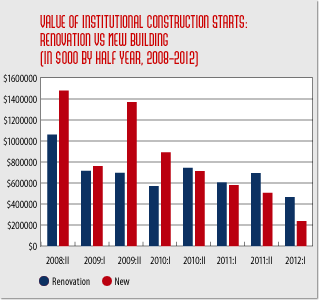
Value of construction starts by nyc institutions down 41 percent in first half of 2012
Public Schools Experience Steepest Declines, Though Major Higher Education Projects on Horizon
New York City’s public and private institutions initiated $704 million in construction projects during the first six months of 2012, down from $1.2 billion in the first half of 2011, according to a New York Building Congress analysis of McGraw-Hill Construction Dodge data. The 41 percent decrease in institutional construction starts was primarily a result of steep declines in new projects initiated at New York City’s public schools and institutions of higher learning.
The first half of 2012 represents an accelerating downward trend. The value of New York City institutional starts reached $2.4 billion for all of 2011, down from $2.9 billion in 2010 and $3.8 billion in 2009.
The data encompass all recorded project starts, including new construction as well as alterations and renovations to existing structures, and reflect the estimated value of each initiated project through the entire period of construction. The sectors examined include elementary and secondary schools, hospitals and health care, higher education, courts, libraries, cultural facilities and religious institutions.
Sector Breakdown
Over a four-year period from July 2008 through June 2012, educational facilities accounted for more than half of all construction starts (by value) among public and private institutions in New York City. Public elementary and secondary schools alone accounted for 37 percent of all construction starts, while public and private colleges and universities accounted for another 14 percent.
Public and private hospitals and healthcare facilities accounted for 26 percent of all institutional construction starts by value during the four-year period. Cultural facilities were responsible for another 12 percent of all initiated projects. Court facilities, private elementary and secondary schools, religious institutions and libraries each contributed less than 5 percent of all institutional construction starts by value.
Decreasing construction activity in the public schools sector is the primary cause for the overall decline in the institutional sector. Public elementary and secondary school construction starts reached $1.3 billion in 2009 and $1.2 billion in 2010, before dropping to $746 million in 2011. Construction starts have fallen even further in the first half of 2012 - to $169 million (a 62 percent drop compared to the first six months of 2011).
In the other major sectors:
- Construction starts by public and private colleges and universities reached $59 million in the first half of 2012. Construction starts in the first half of 2011 reached $257 million thanks to the initiation of three major projects by Columbia and Fordham Universities, as well as Vaughn College of Aeronautics.
- Hospitals and health care starts rose from $229 million in the first six months of 2011 to $273 million in the first half of 2012.
- Cultural construction starts rose slightly - from $121 million in the first half of 2011 to $123 million during the same period in 2012.
Alterations and renovations to existing facilities have surpassed brand new construction in the institutional sector over the past 18 months. In 2009 and 2010, new, ground-up construction represented approximately 55 percent of all starts by value. In 2011, however, 55 percent of all construction starts were renovations. That number has jumped to 66 percent in the first six months of 2012.
“New York’s public and private institutions have continued to invest, but at least for the time-being, the general focus has been on upgrades to existing structures rather than brand new facilities,” noted New York Building Congress President Richard T. Anderson. “When we analyzed the list of top 10 projects from each sector over the past few years, we noticed that the majority occurred between 2008 and 2010.”
Educational Outlook
New York City is on the verge of a decades- long building boom in higher education. Chief among the projects moving forward are Columbia University’s Manhattanville expansion, New York University’s NYU 2031, and Cornell University’s CornellNYC Tech, on Roosevelt Island.
In addition, the City University of New York (CUNY) has plans for more than $2.1 billion worth of construction over the next five years, highlighted by new facilities for the College of Staten Island, Lehman College and Brooklyn College. Fordham University also is in the early stages of its Lincoln Center campus expansion.
"These are truly exciting times for New York's colleges and universities," said Mr. Anderson. "The determination of these institutions to build for the future is critical to our industry and the City. In the short-run, these projects mean construction jobs and economic activity. In the long-run, they expand the collective strength and contributions of the higher education sector as an economic engine of the New York City economy. What's more, these investments help ensure the City's global competitiveness, while also preparing the next generation of leaders and innovators."
The prospects are not as bright in the near-term for public elementary and secondary school construction spending. Under Mayor Bloomberg’s leadership, the City has made incredible progress adding capacity and modernizing existing facilities. From Fiscal Years 2005 through 2009, the City invested $13.1 billion in its network of schools throughout the five boroughs. But given the constraints brought on by the recent economic downturn, the City’s planned investments drop to $11.3 billion in the current five-year plan, which runs through Fiscal Year 2014.
According to its most recent amendment to the plan, the City plans to invest $2.0 billion in school construction for the coming fiscal year and $2.4 billion in the last year of the plan. This is down from the $2.9 billion in expenditures budgeted for the Fiscal Year that ended on June 30 of this year.
Mr. Anderson concluded, "While the City's capital investments, especially in the public school system, over the last decade were historically high, the trend lines for capital spending are now clearly headed downward. Government and civic leaders need to be vigilant about protecting the investments that improve quality of life, bolster the economy, and add to the vitality of the City."
Charts and Diagrams

Source: McGraw-Hill Construction Dodge*

Source: McGraw-Hill Construction Dodge*

Source: McGraw-Hill Construction Dodge*
* Dodge data used for this analysis can be purchased at dodge.construction.com



